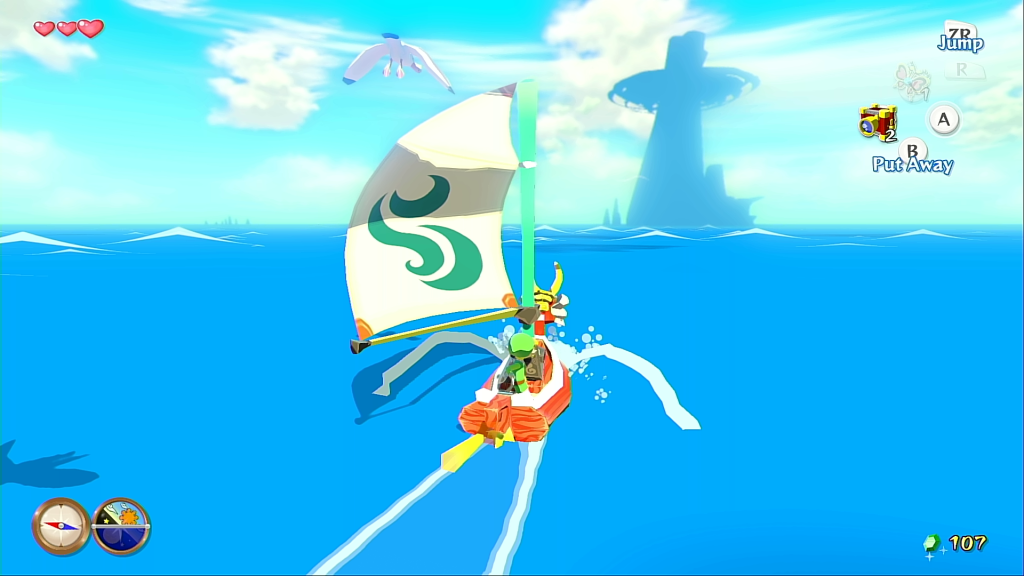The Wind Waker‘s vast, rolling sea lodges firmly in the memory of anyone who’s ever played it. It’s a truly magical bit of design: the way it cycles between various shades of blue, the vaguely psychedelic patterns shifting across its surface, the calligraphic spirals of wind that whip across its surface and the undulating waves that feel as if the game world is urging you on to adventure.
Seventeen years on from its GameCube release (and seven on from its HD sprucing-up on Wii U) it’s still one of the most enticing oceans ever put to silicon. Sure, The Wind Waker‘s vintage water tech may pale in comparison to the latest and greatest oceanic games, but it’s difficult to deny that Nintendo didn’t absolutely nail the thrill of your sail catching the breeze as you set out to see what’s on the horizon.

I was pretty jazzed about getting to The Wind Waker in my Zelda series playthrough. I bought it at launch in 2003 and had nothing but fun recollections. Not even the annoyance of having to buy a Wii U (an absolute dog of a console) to play the HD remaster that Nintendo stubbornly refuses to port to Switch tempered my excitement.
It doesn’t come as a shock that the game still looks incredible. I was initially sceptical of the HD version’s slight softening of the cel-shaded aesthetic, but in motion it makes the game look gorgeous. The Wind Waker has perhaps the strongest visual unity in the entire series – combining a Studio Ghibli-style otherworldly design ethos, a brilliant lighting engine and very characterful animation (big fan of the moblins’ wobbly noses).

Link has never been more communicative, his features so expressive that you forget he’s a silent character. The way he hunches over behind his shield in front of a massive armored knight, nervously sidles along a cliff face or skips along in a barrel is a masterclass in animation.
The pinnacle of it all comes in the jaw-dropping moment mid-way through the game to discover the old Hyrule Castle frozen in time beneath the waves. You can cut the atmosphere here with a knife and descending into the Master Sword chamber to see stained-glass windows depicting the Ocarina of Time sages is still one of the finest moments in the franchise to date.

All of the above lived up my memories of 2003. The rest? Well, turns out there was a reason I’d forgotten most of the rest of the game.
The Wind Waker has a deserved reputation for being easy. This isn’t necessarily a bad thing, though the fact that I didn’t come close to dying at any time in this playthrough does drain some tension from the game. But while the combat is serviceable enough stuff, the dungeon design left me cold.

It’s not just that there’s only four (and a bit) of them, it’s that there’s a shift in design philosophy that rubs me up the wrong way. My favorite Zelda dungeons place you inside what amounts to a giant machine that you must learn to manipulate – actions in one room can transform the entire place and you must master the environment to succeed.
This is almost entirely absent. In The Wind Waker each dungeon room is its own self-contained puzzle that you solve in isolation and move onto the next. The solutions rarely require you to think outside the box and pale next to the intricacies of Ocarina of Time and Majora’s Mask. The bosses are also a complete pushover, each one solved by using the dungeon item on it. That’s a cliche Zelda complaint, but if the Oracles games can surmount it then this could too.

This lack of roughage in The Wind Waker adds up and it sometimes strays into the outright dull. Shigeru Miyamoto himself admitted that the oceanic travel – while great-looking – is a bit boring. He’s right, and even the HD remix’s inclusion of a ‘speed sail’ doesn’t solve that getting from A-B is just pointing in the right direction and letting the game trundle across the ocean.
Viewed in the most charitable way, this would be a great first Zelda for a new player. All The Wind Waker asks is for you to sit back, relax and let it gently lead you through a friction free adventure. It succeeds at that (and is generally a fine bit of video game), but to a player who’s already bashed Ganon in the head across multiple Zeldas, a beautiful graphical style can only take you so far.
Oh well, onto The Minish Cap, which I’ve never played before. .
4 thoughts on “The Legend of Zelda: The Wind Waker (GameCube, 2003 / Wii U, 2013)”